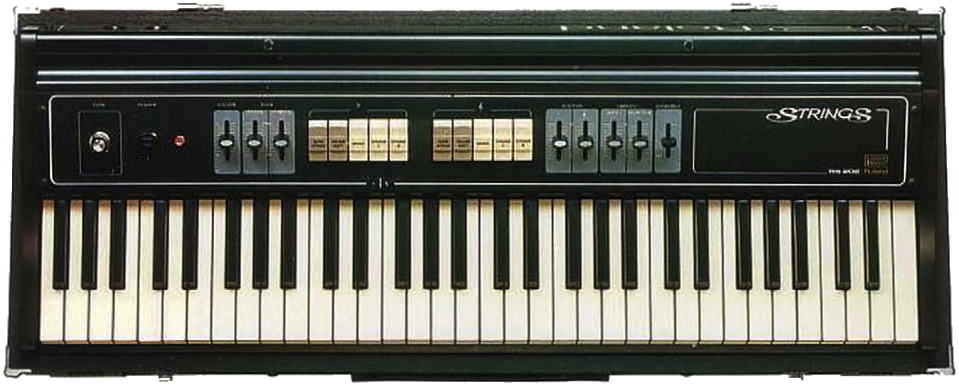String machine

Roland RS-202
A string machine is a paraphonic synthesiser designed to make lush violin ensemble sounds. It's not as versatile as a fully fledged synthesiser, but it can play chords, making it a useful addition at the time.
A brief history
In the 1970s, string machines provided a comparatively modern and appropriately synthetic alternative to recording playback keyboards, the previous polyphonic option for limited sounds and unlimited notes. With no moving parts, they were cheaper, smaller, lighter, and more robust. This made them a sensible option, especially for touring.
Once microprocessors became affordable, string machines were in turn replaced by polyphonic synthesisers, samplers, and romplers. Not only did these sound better, but if you got a vintage synthesiser themed sample CD or expansion board, they could even sound the same, while still giving you full polyphony (as opposed to string machines' paraphonic block chords).
Under the hood
Most synthesisers have a certain number of oscillators (usually one or two) per voice. The more oscillators you have, the more notes you can play at once. In contrast, a string machine has just one oscillator, and a lot of dividers that derive the sounds of all the other notes from it, all at once, all the time. When you play a note, you're just toggling whether that note's sent to the internal mixer, but it's always playing.
As a result, it's a markedly different type of synthesis with different constraints and abilities:
- As all the sounds of all the notes you're playing are fed into a single VCA, you can essentially only play block chords, with all the notes fading in and out together
- You can't give any specific note portamento, though you're welcome to slide the pitch of all the notes together
- Relative to that one oscillator, all the notes are always perfectly in tune with each other
- The polyphony is unlimited — you can play all the notes all at once if you want to
Polyphonic synthesisers have an ideal, but somewhat brute force, approach of adding more VCOs, VCFs, and VCAs — and, accordingly, cost — per voice. String machines provide a more affordable alternative, letting you play full chords (as opposed to broken chords) without having to resort to multitracking a monophonic synthesiser.
Example implementations
Further reading
Deep dives
- "Synth Secrets: Synthesising Strings: String Machines" Gordon Reid, Sound On Sound, Feb 2003
- "Adventures in Top Octave Generation" Tom Wiltshire, Electric Druid, 2016
Types of hardware: Drum machine | Line mixer | Sampling workstation | String machine
String machines: RS-101 | RS-202 | Solina String Ensemble | String Ensemble | VC340 | VP-330

